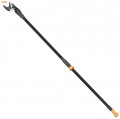Max. cutting diameter
The largest diameter (thickness) of a branch that the tool can handle.
The larger the maximum cut diameter, the more powerful this model, the lower the likelihood that a certain branch will be too tough for the tool. At the same time, note that to ensure high power, long handles and strong blades are needed, which accordingly affects the dimensions, weight and price. Therefore, it is worth choosing according to this parameter with a certain margin, but at the same time, this margin should not be too large.
As for specific figures, a maximum diameter
of 20 mm or less is considered relatively small, but it often turns out to be quite enough for simple work.
21 – 30 mm — the average value,
31 – 40 mm — above average, and in loppers the maximum thickness can
exceed 40 mm.
Max. pole saw cutting height
The maximum height that the pole saw (see "Type") can reach while standing on the ground, without the use of ladders or other attachments.
This parameter is usually indicated by manufacturers according to the following principle: “the length of the rod plus the height of a person with arms raised” (usually 2–2.5 m is taken for a person’s height). When choosing according to cutting heights, note that more “long-range” tools are usually heavier, bulkier and more expensive than relatively short counterparts. So the headroom does not hurt, but it should not be too large.
It is also worth noting that the cutting height is indicated relatively rarely — mainly in the largest and longest tools, where this figure is 3 m or more. In shorter models, the range can be derived using the already mentioned formula "length plus height of the user with arms raised."
Detachable blade
The presence
of a removable blade(blades) in the design of the tool. This feature provides additional convenience and savings. First, the blade is usually more convenient to sharpen and clean by removing it from the tool; secondly, a damaged blade can be replaced with a new one purchased separately — this is cheaper than purchasing a whole new tool.
Blade adjustment
The ability
to adjust the blades of the tool. The specific meaning of this option in different models may be different, it should be clarified separately. So, in some cases we are talking about adjusting the distance between the blades, in others — about the angle of the blades relative to the handles, etc. However, anyway, this feature provides additional options for setting the tool for different situations.
Handle material
—
Plastic. Relatively simple and at the same time quite practical, as a result — a common material. Plastic perfectly resists moisture, almost does not cool hands in cool weather, and is relatively inexpensive. As for strength and reliability, they are generally somewhat lower than those of metals, and most tools with plastic handles are designed mainly for simple work with relatively low loads. However, there are exceptions — for example, powerful loppers, which use high-quality durable plastic grades for handles. Anyway, for additional convenience, handles made of this material are often supplemented with rubber pads.
—
Steel. The key advantage of steel is its high strength, which makes it possible to use this material even in the most powerful tools designed for thick branches. Compared to another metal — aluminium — steel weighs a little more, but costs less. For additional resistance to corrosion and ease of holding, steel handles can be coated with paint or equipped with additional overlays, most often of rubber or plastic.
—
Aluminium. Another metal used for handles is along with steel. Aluminium differs from it, on the one hand, in lower weight and better resistance to corrosion, on the other hand, in higher cost. However, the difference in price is not so great, so these handles are also very popular. They can also be equipped with various overlay
...s for added convenience.
— Tree. "Classic of the genre", not out of use today. The wood is pleasant to the touch, does not cool hands in cool weather and looks good. In terms of reliability, this material is comparable to plastic: it is inferior to steel and aluminium, but it is quite applicable even in fairly powerful tools. The unequivocal disadvantages of wood include poor resistance to scratches and chips. Because of this, accidental contact with sharp objects can lead to the appearance of chips, fraught with splinters. In addition, this material does not tolerate constant contact with moisture, and it is advisable to store a tool with wooden handles in a dry place. Note that for a number of reasons, the tree is used mainly in one-handed tools.